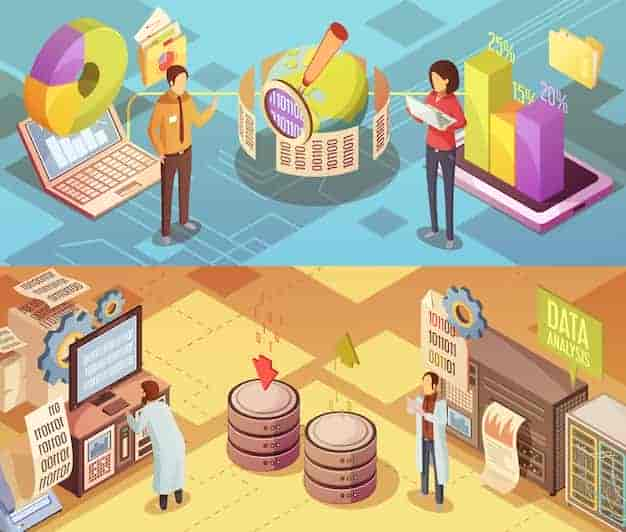The Role of Data in Market Segmentation
Ellie Moore

Photo: The Role of Data in Market Segmentation
In today's highly competitive business landscape, understanding your audience is essential for success. Market segmentation is one of the most effective strategies for targeting specific groups of consumers and tailoring products or services to meet their needs. At the heart of effective market segmentation lies data an invaluable resource that provides actionable insights and drives decision-making. This article explores the critical role of data in market segmentation, highlighting its benefits, applications, and best practices.
What is Market Segmentation?
Market segmentation is the process of dividing a broader market into smaller, more manageable groups based on shared characteristics. These segments can be demographic (age, gender, income), geographic (location), psychographic (lifestyle, interests), or behavioral (purchasing habits, brand loyalty). The purpose of segmentation is to create targeted marketing strategies that resonate with each group, ultimately improving customer satisfaction and boosting sales.
For segmentation to be effective, businesses need accurate, relevant, and comprehensive data. This is where the integration of data analytics becomes indispensable.
Why Data is the Backbone of Market Segmentation
Data enables businesses to understand their audience on a granular level, paving the way for personalized marketing efforts. Here are some key reasons why data is fundamental to market segmentation:
1. Identifying Customer Characteristics
Data helps businesses identify who their customers are and what they need. By analyzing customer demographics, purchase history, and preferences, companies can pinpoint specific traits that define each market segment.
2. Enhancing Targeted Marketing
With data-driven insights, marketers can craft campaigns tailored to the unique interests and behaviors of each segment. This increases the likelihood of engagement and conversion, reducing wasted resources on generic strategies.
3. Predicting Customer Behavior
Behavioral data, such as browsing patterns, transaction history, and engagement metrics, allows businesses to predict future actions. This predictive capability is vital for proactive marketing and inventory management.
4. Improving Customer Retention
Data-driven segmentation helps identify the needs of loyal customers, enabling businesses to provide value that fosters long-term relationships. Retention strategies can be customized for each segment, improving customer satisfaction and reducing churn.
Types of Data Used in Market Segmentation
Effective segmentation relies on various types of data. Each plays a unique role in understanding the market:
1. Demographic Data
This includes age, gender, education level, and income. It provides a foundational understanding of who the customers are and how they might interact with a product or service.
2. Geographic Data
Location-based data helps companies target specific regions, cities, or neighborhoods. It’s particularly useful for businesses with physical storefronts or region-specific offerings.
3. Psychographic Data
Psychographic data focuses on lifestyle, values, interests, and attitudes. It delves deeper into the “why” behind consumer behavior, offering insights into motivations and emotional drivers.
4. Behavioral Data
Behavioral insights, such as purchase history, website interactions, and loyalty program participation, reveal how customers engage with a brand. This data is instrumental in crafting personalized experiences.
5. Real-Time Data
With the advent of IoT and big data analytics, real-time data allows businesses to react promptly to changes in consumer behavior or market conditions. For example, online retailers can use real-time browsing data to suggest products dynamically.
How Businesses Use Data for Market Segmentation
1. Data Collection
The first step is gathering data from multiple sources. These can include customer surveys, CRM systems, social media analytics, website cookies, and third-party databases.
2. Data Analysis
Once collected, the data is analyzed to uncover patterns, trends, and correlations. Modern tools like artificial intelligence (AI) and machine learning (ML) enhance this process by processing vast amounts of data quickly and accurately.
3. Creating Segments
Using the insights derived from analysis, businesses can create detailed customer profiles or personas. Each persona represents a distinct market segment, complete with attributes, preferences, and behaviors.
4. Personalizing Marketing Campaigns
With well-defined segments, businesses can develop highly targeted marketing campaigns. For example, an e-commerce store might promote fitness products to health-conscious customers while advertising tech gadgets to tech-savvy shoppers.
5. Continuous Monitoring
Market segmentation is not a one-time process. Consumer behavior evolves, and businesses must continually monitor data to keep their segmentation strategies relevant.
Challenges in Data-Driven Market Segmentation
While data offers immense benefits, leveraging it effectively comes with challenges:
1. Data Privacy Concerns
With stricter regulations like GDPR and CCPA, businesses must ensure they collect and store data ethically and transparently.
2. Data Accuracy
Inaccurate or outdated data can lead to poor segmentation, resulting in ineffective marketing strategies. Regular updates and verification are crucial.
3. Over-Segmentation
Excessive segmentation can lead to fragmented strategies that dilute marketing efforts. Striking the right balance between specificity and practicality is key.
4. Integration of Data Sources
Data often comes from diverse sources, making integration a complex task. Ensuring consistency across platforms is essential for accurate analysis.
Benefits of Data-Driven Market Segmentation
Despite the challenges, businesses that embrace data-driven segmentation enjoy significant advantages:
- Increased ROI: Targeted campaigns lead to higher engagement rates and better conversion, maximizing return on investment.
- Better Resource Allocation: Data helps allocate marketing resources to the most profitable segments.
- Enhanced Product Development: Insights from segmentation guide product innovation and development based on customer needs.
- Improved Customer Experience: Personalized interactions foster deeper connections with customers, enhancing overall satisfaction.
Future Trends in Data-Driven Market Segmentation
The future of market segmentation lies in advanced technologies and data integration:
- AI and Machine Learning: These technologies will enable even more precise and dynamic segmentation by identifying patterns that humans might miss.
- Predictive Analytics: Predictive tools will allow businesses to anticipate customer needs and adapt strategies proactively.
- Omnichannel Data Integration: Seamless integration of data across digital and physical touchpoints will provide a 360-degree view of the customer journey.
Conclusion
Data is the lifeblood of effective market segmentation. It empowers businesses to understand their customers, anticipate their needs, and deliver personalized experiences. By leveraging demographic, geographic, psychographic, and behavioral data, companies can craft targeted marketing strategies that drive engagement and revenue.
However, the journey doesn’t end with segmentation. Continuous data analysis, ethical practices, and the adoption of emerging technologies are essential for staying ahead in an ever-evolving market. Businesses that master data-driven segmentation will not only gain a competitive edge but also build lasting relationships with their customers.
Incorporating data into your segmentation strategy is no longer optional it’s a necessity for success in the modern marketplace.
Finance & Investment
View All
June 18, 2025
Plus Finance Making Borrowing EasierMaster expert SEO content for organic growth. Drive traffic, rank higher, and convert customers using E-E-A-T, keyword research, and user intent strategies.
Ellie Moore

February 15, 2025
Benchmarking Best Practices for 2024Stay updated with the best practices in industry benchmarking for 2024. Learn how to measure and achieve peak performance.
Ellie Moore

May 20, 2025
Compare Home Finance Rates 2025Unlock organic growth with expert SEO content. Learn to create valuable, user-focused content that satisfies search engines and your audience for lasting succes...
Ellie Moore

April 7, 2025
TD Auto Finance Phone Contact DetailsUnlock higher rankings & engaged readers with expert SEO content. Learn to create valuable, authoritative content that Google's E-E-A-T and Helpful Content syst...
Ellie Moore

August 16, 2025
Discover Yahoo Finance for Smarter InvestingUnlock top search rankings & build trust with expert SEO content. Discover how E-E-A-T aligned, high-value content helps you stand out and drive growth.
Ellie Moore

January 17, 2025
Think Like an Entrepreneur TodayLearn how to think like a successful entrepreneur and build the mindset needed for business success.
Ellie Moore
Insurance
View AllExplore how your credit score affects insurance premiums. Learn how to improve your score and save on coverage!
Ellie Moore
Discover how lifestyle changes, like quitting smoking or driving less, can unlock insurance discounts. Start saving now!
Ellie Moore
Explore aviation insurance options, from aircraft liability to passenger protection. Secure the skies for your operations!
Ellie Moore
Discover how artificial intelligence simplifies claims, enhances accuracy, and speeds up insurance processes.
Ellie Moore
Learn what umbrella insurance covers and who benefits from it. Secure your financial future with added protection.
Ellie Moore
Understand how insurers assess risks to calculate premiums. Learn how your profile impacts your policy cost.
Ellie Moore
Education
View AllLearn effective classroom strategies to manage ADHD. Discover how teachers can support students with ADHD for better learning outcomes.
Read MoreExplore the ongoing debate on standardized testing. Learn its pros, cons, and whether it should remain a key part of education.
Read MoreDiscover why liberal arts education remains valuable in today’s tech-driven world. Explore how it fosters critical thinking and adaptability.
Read MoreMOOCs are transforming the landscape of higher education. Learn how massive open online courses are making learning accessible to all.
Read MoreDiscover how AI-powered personalized learning is reshaping education. Learn how smart tech tailors content to fit individual student needs.
Read MoreRevive ancient teaching with the Socratic method! Learn how this questioning approach encourages deep thinking and active learning.
Read MorePopular Post 🔥
View All
1
2
3
4
5
6
7
8
9
10
Health






Automotive
View All
September 5, 2025
Top Automotive Swap Meets Near Me This Year
Unearth automotive treasures at vibrant swap meets! Find rare parts, classic cars, & connect with enthusiasts. Your guide to top events this year.

August 21, 2025
City Automotive Experts Ready To Help
Your guide to trusted city automotive experts. Discover how local mechanics offer expert care, build trust, and ensure your vehicle's safety & longevity.

August 3, 2025
Choosing The Best Automotive Spray Gun For Jobs
Achieve a flawless finish! Our guide helps you choose the perfect automotive spray gun, covering HVLP, RP, and LVLP types for pro results.

February 13, 2025
Car Photography: Pro Tips for Stunning Shots
Capture stunning automotive photos with these expert tips. Learn techniques to showcase cars in the best light and angles. Ready to snap?

September 7, 2025
Capital Automotive Services For Every Budget
Don't let car care break the bank! This guide shows how affordable automotive services and smart maintenance keep your vehicle safe and save you money.

September 13, 2025
What Lincoln Automotive Financial Can Offer
Embark on luxury vehicle ownership. Experience refined elegance & innovative spirit for an exciting journey ahead.

















